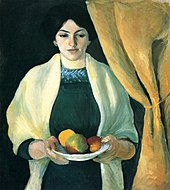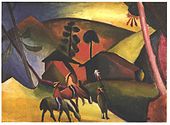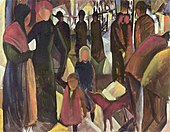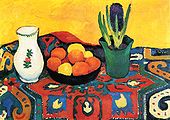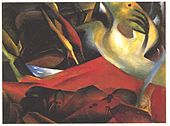August Macke
August Macke Robert Ludwig (* 3. January 1887 in Meschede , Sauerland ; † 26. September 1914 in Perthes-lès-Hurlus , Champagne ) was one of Germany's most famous painter of Expressionism . He took part in the two Blue Rider exhibitions .
In around ten years, Macke created a work that, under the influence of the diverse art movements of the time, quickly changed stylistically. The personal style that he finally found and that is now felt to be typical of Macke is shaped by the preoccupation with the effects of light and the use of pure, bright, harmonious colors. The paintings appear cheerful and light, anything tragic is alien to them. "His pictures satisfy the longing for positive images of an intact world, the harmony of people with the things that surround them."
Life
Origin and school time
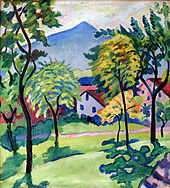
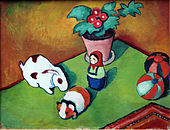
August Macke was born on January 3, 1887 in Meschede in the Sauerland. His father August Friedrich Macke (1845–1904), a civil engineer and moderately successful building contractor, drew and collected old engravings and coins in his spare time . The mother Maria Florentine Macke, née Adolph (1848–1922) came from a rural family. After his two older sisters Ottilie and Auguste, August was the third child in the family. Elisabeth Lowitsch, the wife of the Berlin trade unionist and politician Heinrich Kreil , was his second cousin.
Soon after August's birth, the family moved to Cologne , where he attended high school from 1897 . After moving to Bonn again in 1900, he switched to the secondary school there . During his school days, August Macke demonstrated a talent for drawing and painting and a keen interest in art.
In 1903 he met his future wife Elisabeth Gerhardt , the daughter of the Bonn manufacturer Carl Gerhardt . From then on Elisabeth became his most important model; he portrayed her more than two hundred times. Her uncle, the wealthy Berlin entrepreneur, art collector and patron Bernhard Koehler , would later support Macke several times.
education
In 1904, against his father's wishes, he left school in the lower prima and began training at the Royal Art Academy in Düsseldorf . He soon criticized the rigid curriculum and, above all, the constant drawing from plaster casts. He attended the academy only occasionally and left it prematurely in November 1906. At the same time, in 1905 he took courses at the Düsseldorf School of Applied Arts , which gave him more ideas.
Through his friend Wilhelm Schmidtbonn , he came into contact with Louise Dumont and Gustav Lindemann , who were trying to reform the theater at the Düsseldorfer Schauspielhaus . With great enthusiasm August Macke designed stage decorations and costumes for a number of performances in 1906. Schmidtbonn described the then 19-year-old Macke: “He was broad and tall, with a healthy and smiling face. His shape, face, and voice filled our room unusually. [...] He showered us with strength and lust for life that we thought we had enough ourselves ... "
On a trip to Paris in 1907, Macke met Impressionist paintings that made a deep impression on him. He then decided to complete his training with a German impressionist. His choice fell on Lovis Corinth , who gave courses at a private art school in Berlin. Macke also visited many Berlin museums during the six-month study visit.
In 1908 a trip to Italy followed and, together with Elisabeth Gerhardt and Bernhard Koehler, a second trip to Paris. The reason for this trip was Koehler's wish to add works from French Impressionism to his collection, with August Macke acting as a consultant.
Military service and marriage
From October 1908 he did his one year military service , which almost completely interrupted his artistic work. After completing his military service, he married Elisabeth Gerhardt in October 1909. The couple's existence was secured by income that Elisabeth Macke received from her paternal inheritance and which, although not luxurious, made possible a carefree existence. In 1910 and 1913 respectively, the sons Walter and Wolfgang were born.
Painting and exhibition activities
The honeymoon again led to Paris, where August Macke encountered works by the Fauves and the Futurists . Afterwards, the couple moved to Tegernsee at the invitation of Schmidtbonn at the end of October . The son Walter Carl was born there on April 13, 1910. The year spent in the quiet and seclusion of Upper Bavaria was a particularly productive creative phase for August Macke.
At an exhibition in early 1910 he met Franz Marc . With the seven-year-old senior, he soon formed a close friendship and a lively exchange of ideas on artistic issues. In September 1910 he visited an exhibition of the Neue Künstlervereinigung München , where works by the Fauves and the beginning Cubism were shown. Unlike Marc, who joined the association, Macke had reservations about the painting of the members: “[...] it doesn't shake me. I am very interested. [...] But the means of expression are too big for what they want to say. "
In November 1910 the family returned to Bonn and in February 1911 they moved into a house belonging to their mother-in-law (Bornheimer Straße 88, today 96), today's August-Macke-Haus. A studio could be expanded for him there. More than 330 paintings were created during his time in Bonn. The Bonn student Max Ernst became friends with Macke in 1911 and decided the following year, encouraged by the recognition and support of Macke's circle of friends, to become a painter.
In 1962, his wife Elisabeth wrote about the garden picture in her memoirs: “In spring everything was bathed in a sea of flowers. Behind the house our large garden, barn and vegetable garden. "
In mid-1911, two members of the Neue Künstlervereinigung, Wassily Kandinsky and Franz Marc, decided to bring out their own publication, the almanac Der Blaue Reiter , which appeared only once . At the request of Marc, Macke took part in the editing of the almanac and contributed the essay Die Masken ; he also arranged for Bernhard Koehler to secure the financing. When the editors of the Almanac resigned from the artists' association at the end of 1911 in order to carry out their own exhibitions under the name Der Blaue Reiter , Macke joined in. In the first exhibition of the Blauer Reiter , which was shown first in Munich in 1911/12, then in Cologne, Berlin, Hagen and Frankfurt, Macke was only represented with three paintings by which he felt himself insufficiently represented. His relationship with the Blue Rider had always been ambivalent; Although at times he was deeply impressed by Kandinsky's painting, he had reservations about the high intellectual demands of the artists as well as about Kandinsky's dominant personality. Although he sent the second exhibition of the Blauer Reiter , which took place from February to April 1912 and featured graphic works, by that time he had already distanced himself artistically from the group. Together with Franz Marc he painted a wall of his studio with the paradise that represents Adam and Eve, according to his suggestion in 1912 .
The three years in Bonn were a time of lively exhibition activity for Macke. Exhibitions in well-known galleries ensured that his reputation grew beyond Germany, among other things by participating in an exhibition by Karo-Bube in Moscow. He also appeared as an organizer of important exhibitions. In the Gereonsklub in Cologne he showed works by previously little known avant-garde artists and campaigned for the presentation of the Blue Rider in the Rhineland . In 1912 he was a member of the working committee for the Sonderbund exhibition in Cologne. He was the initiator of the 1913 exhibition of Rhenish Expressionists in Bonn. He played a key role in organizing the autumn salon in Berlin in September 1913.
In his distance from the Blue Rider , he advised his friend Marc "to work without thinking about the 'Blue Rider' and blue horses." In 1913 he painted a picture with the title parody of the Blue Rider . The watercolor shows Marc on the driver's seat to the left of the middle, Kandinsky sitting in the carriage to the right, and the profile of Herwarth Walden at the top right . At the bottom right Macke is small and insignificant. The picture is covered with flowing lines and patches of color and caricatures Kandinsky's abstract style.
In order to gain distance from the art business and to be able to concentrate on his own work in peace, Macke and his family moved to Hilterfingen on Lake Thun in autumn 1913 . The painter Louis Moilliet , whom Macke had already met in Switzerland in 1909, lived in the immediate vicinity . Even Paul Klee was not far away. The most important pictures of his oeuvre were created in Hilterfingen .
In April 1914, the stay was interrupted by a fortnightly trip to Tunisia with Paul Klee and Louis Moilliet . The trip to Tunis came about at Klee's instigation. He wanted a study trip on which the painters should stimulate each other. In Tunisia, they visited, among other places, Carthage , Hammamet , Sidi bou Said and Kairouan . Macke came back from this trip with a wealth of photos, drawings, and watercolors; some of them he used in Hilterfingen and later in Bonn as a basis for paintings. From May 1914 Macke was represented with the oil painting "Window" in the so-called "Expressionist Hall", which Adolf Hölzel had put together on behalf of the Association of Art Friends in the countries on the Rhine with the participation of 24 artists. Shortly before, Oskar Schlemmer's Neuer Kunstsalon am Neckartor in Stuttgart had shown works by August Macke and Eugen Zeller in one of his last events in a double exhibition.
In the second half of June the couple returned to Bonn, where August Macke stayed for six weeks of intensive work.
Death in the First World War
When the First World War broke out , Macke was drafted into Infantry Regiment No. 160 on August 1, 1914 . His letters from the field are under the impression of the horror and cruelty of the war. He fell on September 26, 1914 at the age of 27 as a deputy officer on the Western Front near Perthes-lès-Hurlus in Champagne. Macke is buried in a collective grave at the Souain military cemetery.
plant
Influences and development
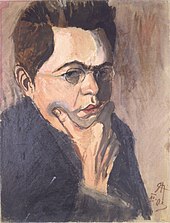
August Macke was open to the diverse artistic trends of his time and experimented with the new painting styles in his pictures. Due to the changing influences, his work shows a rapid stylistic change despite the short creative period of around ten years.
At the age of 18 he read Schopenhauer's Die Welt as Will and Idea , which made a great impression on him. Life is, as Schopenhauer wrote, among other things, to admit the poets, a long dream. This lost dream, these visions of paradise can also be found in the faces of the figures in Macke's pictures and, sometimes only hinted at, in the overall mood of the paintings.
Early work
At first, Macke oriented himself primarily to the observed environment. The very numerous portraits in his early work show his endeavor to express the personality of the people portrayed. Some of his early paintings are under the influence of Arnold Böcklin , whose symbolist painting seeks to express ideas, thoughts or moods through pictorial means. Macke's painting Autumn (1905) seems to be inspired by Böcklin's autumn thoughts . Hans Thoma is named as a role model from this phase , to whose loneliness Macke's walkers from 1907 go back.
impressionism
In 1907 he got to know pictures of French Impressionism on his first trip to Paris , initially through black and white illustrations and publications by the art historian Julius Meier-Graefe . This caused a boost in his artistic development. “I don't understand that I was able to hang onto Böcklin, Thoma's emotional painting, for so long. […] I'm rid of her forever, ”he wrote in 1907 to his friend Elisabeth. He now turned his attention away from the motif and turned to the effect of the picture itself, whereby he was particularly interested in light and color, their harmony. Temporarily, for example in the painting Am Rhein near Hersel , he used the typical impressionist painting technique of small, blurred brushstrokes. Above all, however, the influence of Impressionism had an impact on his choice of subjects. Macke now preferred everyday motifs without symbolic content: his own domestic environment, gardens, landscapes, strollers, animals in the zoo.
Macke's particular admiration among Impressionist painters went to Édouard Manet . His role model was still effective in the choice of motifs and image composition when Macke had already left the impressionistic painting style behind him; the Staudacherhaus on Tegernsee from 1910 can be traced back to Manet's country house in Rueil .
expressionism
In the course of the Tegernsee year, Macke's style of painting changed again, this time under the influence of the French Fauves , but also the German Expressionists , including members of the Neue Künstlervereinigung München, such as Franz Marc and Gabriele Münter . His paintings now show bright colors and simplified forms, which are often outlined with a dark line. The depth of the space recedes in favor of a two-dimensional effect, and an interest in the ornamental can often be recognized. The numerous still lifes that Macke painted from now until around 1912 show the influence of Henri Matisse, whom he admired .
During his contact with the Blauer Reiter , Macke sometimes experimented with an abstract painting style based on the example of Wassily Kandinsky and Franz Marc. Among other things, the painting The Storm , which was depicted in the Almanac of the Blue Rider , was created. Macke gave up this painting style, which was atypical and inappropriate for him, in the course of 1912.
Mature style
The painting Walkers by the Lake I (1912) marked a decisive turning point in Macke's work. Sharp-edged, acute-angled forms are juxtaposed against each other here in a jerky dynamic, the closedness of the picture surface is dissolved. Macke reacted to the impressions of early Cubism with its forerunners Pablo Picasso and Georges Braque . In the beginning he even adopted the dark, subdued colors of this painting style, which were quite atypical for him. In contrast, the prismatic, overlapping and overlapping elements that have also appeared in Macke's paintings and drawings since 1912 can be traced back to the influences of Futurism . One of his concerns was to express speed through the simultaneous representation of successive processes. One example of this is the large, bright shop window from 1912. The maze of the street is reflected in the shop window, including a horse running to the left, a cab driver moving to the right and a revolver (possibly a poster) in the upper right. Macke was also very impressed by the rhythmically structured, light and color moving images of Robert Delaunay, whom he personally knew . His influence can now be seen in many of Macke's paintings, for example in the fashion store (1913).
August Macke did not fully embrace any of these art movements, but instead took the appropriate elements from them and developed his personal, unmistakable style from them. The objects are now simplified (often as geometric shapes) and subordinated to the color composition, but the objectivity is not completely abandoned. The colors glow, there are no more hard contours. This is exemplified by the garden on Lake Thun from 1913, one of Macke's few pure landscape paintings. The painter had now found his most important themes: woman (s) in front of shop windows, strollers in the park, animals in the zoo. In many of the paintings there is immobility; people are turned away from the viewer, often keeping their heads down and eyes closed as if in meditation. Often there is something dreamy about the pictures. They show Macke's vision of a paradisiacal world.
Macke as a draftsman
Drawing accompanied August Macke throughout his artistic career. He left around 6,000 sketchbooks and around 3,000 single sheet drawings. At first, drawing was a means for him to learn to paint; the drawing helped him to recognize the laws of design. “I almost always have my sketchbook on hand on the street so that I can gradually master the movements of people and animals, because no professor teaches you that,” he wrote to his parents in 1904. Also for study purposes he drew numerous works by other artists during this time. Later he used drawn preliminary studies to prepare paintings. The drawing was an important medium for him to develop his painterly expression. Macke's talent as a cartoonist is highlighted.
reception
Works by August Macke have been shown regularly at exhibitions since 1911. The time of National Socialism brought an interruption , in which Macke's paintings fell under the verdict of “degenerate art” and were removed from public collections. In 1937 his pictures were shown at the “Degenerate Art” exhibition, but removed again after a protest by the German Officers' Association (Macke had been an officer in World War I and was awarded EK 1 ). It is no longer possible to determine which and what number of images were involved. In 1939 the confiscated painting Gartenrestaurant (1912) was sold abroad as part of an auction commissioned by the government.
After the war, works by August Macke were represented at documenta 1 (1955) and documenta III (1964), among others , as well as at group exhibitions abroad.
In 1959, his home region in the Sauerland donated the August Macke Prize ; Since 1989, the city of Bonn has awarded the August Macke Medal every two years . The winners of the August Macke Medal included:
- 1996: Ernemann Sander
- 1997: Douglas Swan
- 1999: Hilla Jablonsky
- 2001: Ulrike Rosenbach
- 2003: Reinhard Puch
- 2008: Dieter Rübsaamen
- 2016: Hans Delfosse
In 1991, the August Macke House Museum was set up in Macke's former home in Bonn .
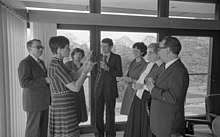
In September 2018, the “Homage to Macke” monument created by Stephan Balkenhol was unveiled in Bonn's Hofgarten.
Important Macke collections are located in the Kunstmuseum Bonn and in the LWL State Museum for Art and Cultural History in Münster, where the estate is looked after and made accessible online through a digitization project.
As part of the series “ German Painting of the 20th Century ”, a 100-pfennig special postage stamp was issued in June 1992 by the Deutsche Bundespost with the theme of fashion business .
Exhibitions (selection)
- July 6 - September 16, 1962: August Macke. Municipal gallery in the Lenbachhaus and Kunstbau Munich.
- March 24 - August 26, 2018: August Macke. Strollers in the garden of art. City Museum Lindau .
- February 10 - May 12, 2019: Marc Macke Nolde. The silence in the noise of time. Masterpieces from the Ziegler Collection. Moritzburg (Hall)
- March 6 - June 17, 2019: Franz Marc / August Macke. L'aventure du Cavalier bleu Musée de l'Orangerie , Paris
- September 1 - December 8, 2019: August Macke up close. Sauerland Museum , Arnsberg
literature
- Mathias T. Engels: August Macke . Monographs on Rhenish-Westphalian contemporary art 1. Bongers, Recklinghausen 1958.
- City Art Museum Bonn: August Macke and the Rhenish Expressionists. Bonn 1973.
- Aurel Bongers, Joachim Heusinger von Waldegg , Dierk Stemmler (eds.): The Rhenish Expressionists - August Macke and his painter friends. Bonn 1984, ISBN 3-7647-0323-7 .
- Ernst-Gerhard Güse (Ed.): August Macke - paintings, watercolors, drawings. Catalog for the 1987 exhibition in Münster, Bonn and Munich. Bruckmann, Munich 1986, ISBN 3-7654-2081-6 .
- Rosel Gollek: Macke, August. In: New German Biography (NDB). Volume 15, Duncker & Humblot, Berlin 1987, ISBN 3-428-00196-6 , p. 617 f. ( Digitized version ).
- Astrid von Friesen: August Macke: a painter's life. Ellert & Richter, Hamburg 1989, ISBN 3-89234-144-3 .
- Peter Dering, Margarethe Jochimsen (ed.): Contemplation and happiness. August Macke's image of man. Exhibition catalog, March 12th - May 28th, 2000. Association August-Macke-Haus, Bonn 2000, ISBN 3-929607-31-X ( series of publications Association August-Macke-Haus. 32).
- Westfälisches Landesmuseum für Kunst und Kulturgeschichte Münster, Landschaftsverband Westfalen-Lippe, Kunstmuseum Bonn (Hrsg.): August Macke and early modernism in Europe. Catalog for the 2001/02 exhibition in Münster and Bonn. Cantz, Ostfildern 2001, ISBN 3-7757-1146-5 .
- Elisabeth Erdmann-Macke : Memories of August Macke. Fischer, Frankfurt am Main 1987 and other editions, ISBN 3-596-25660-7 .
- Hanseatic City of Stade, Kunsthaus Stade , Museum of New Art, Freiburg Municipal Museums, Association August Macke Haus Bonn e. V. (Ed.): August Macke - very private. A journey through the life of August Macke. Wienand, Cologne 2009, ISBN 978-3-86832-007-7 .
- Hildegard Reinhardt : August and Elisabeth Macke. Traces of their relationship (1903–1914). In: My second self. August and Elisabeth Macke. Bonn 2009 ( Association-August-Macke-Haus series of publications. 56).
- Macke, August. In: Josef Niesen : Bonner Personenlexikon. 3rd, improved and enlarged edition. Bouvier, Bonn 2011, ISBN 978-3-416-03352-7 .
- Birgit Poppe: A sky-storming love - August Macke and his wife Elisabeth . Parthas, Berlin 2013, ISBN 978-3-86964-078-5 .
- Birgit Poppe: Macke and his time . Seemann Henschel, Leipzig 2014, ISBN 978-3-86502-331-5 .
- Johannes Wilkes: August Macke - a color novel. Bernstein, Siegburg 2014, ISBN 978-3-939431-87-9 .
- Annegret Hoberg : August Macke, Franz Marc - the war, their fates, their women . Wienand, Cologne 2015, ISBN 978-3-86832-255-2 .
Web links
- Works by August Macke at Zeno.org .
- August Macke house in Bonn
- Lutz Walther, Janca Imwolde: August Macke. Tabular curriculum vitae in the LeMO ( DHM and HdG )
- August Macke on kunstaspekte.de
- Literature by and about August Macke in the catalog of the German National Library
- Works by and about August Macke in the German Digital Library
- Materials by and about August Macke in the documenta archive
- Biography on Rhenish history
- August Macke. Moment. - Publication of all photos by August Macke from Tunisia
Individual evidence
- ^ Westphalian State Museum for Art and Cultural History Münster u. a. (Ed.): August Macke and early modernism in Europe , p. 27.
- ↑ August Mackes Lebensweg , August Macke Haus, Bonn, 2009/10. ( Memento from July 18, 2011 in the Internet Archive )
- ^ Website for the exhibition "My Second Self", August Macke Haus, Bonn, 2009/10. ( Page no longer available , search in web archives ) Info: The link was automatically marked as defective. Please check the link according to the instructions and then remove this notice.
- ↑ Quoted from: Ernst-Gerhard Güse (Ed.): August Macke - paintings, watercolors, drawings , p. 155.
- ^ Ernst-Gerhard Güse (Ed.): August Macke - Paintings, Watercolors, Drawings , pp. 159/160.
- ^ City of Bonn: Macke biography
- ↑ Quoted from: Ursula Heiderich: August Macke - the brightest and purest sound of color , p. 50.
- ^ City of Bonn: Macke biography
- ↑ Katharina Schmidt: August Macke in Bonn - 1910 to 1913. In: Ernst-Gerhard Güse (Ed.): August Macke - paintings, watercolors, drawings , p. 49.
- ^ Lothar Fischer: Max Ernst , Rowohlt, Reinbek 1969, pp. 18-21
- ↑ Rosel Gollek: Indians, Storm and Masks - August Mackes contribution to the Blue Rider. In: Ernst-Gerhard Güse (Ed.): August Macke - paintings, watercolors, drawings , p. 47.
- ↑ LWL-Landesmuseum Münster The mural was removed in 1980 and included in the LWL-Landesmuseum for Art and Cultural History.
- ^ Helmut Friedel, Annegret Hoberg: The Blue Rider in the Lenbachhaus Munich. Prestel, Munich 2013, p. 69.
- ↑ s. Macke, August In: Harald Olbrich (Hrsg.): Lexikon der Kunst. Architecture, fine arts, applied arts, industrial design, art theory. Volume IV: Kony – Mosa , EA Seemann Verlag, Leipzig 2004, ISBN 3-86502-084-4 . (P. 441f)
- ^ Westphalian State Museum for Art and Cultural History Münster u. a. (Ed.): August Macke and early modernism in Europe , p. 336
- ^ Exhibition catalog Art Exhibition Stuttgart 1914 , Kgl. Art building, Schloßplatz, May to October, ed. from the Association of Friends of Art in the States on the Rhine, Stuttgart 1914, p. 48, cat. 412.
- ↑ exhibitions . In: Schwäbische Kronik, second section of the Swabian Mercury , No. 191, Abendblatt, April 27, 1914, p. 1.
- ↑ Bonn in the First World War 1914 to 1918 , see section August 2 , bonn1914-1918.de, accessed on February 15, 2016; Elisabeth Erdmann-Macke, Memories, 2004, p. 319
- ↑ deutschlandradio on September 26, 2004 ( Memento from January 27, 2005 in the Internet Archive )
- ↑ Susanna Partsch: Franz Marc , Taschen, Cologne 2005, p. 88.
- ↑ Ernst-Gerhard Güse (Ed.): August Macke - Paintings, Watercolors, Drawings , pp. 178/179.
- ↑ Hermann Löns and August Macke fell in World War I , broadcast by DeutschlandRadio Berlin on September 26, 2004
- ↑ Deputy Officer, Infantry Regiment 160, 5th Company; Prussian loss list No. 73 of November 10, 1914, p. 2450 / German loss list .
- ↑ German war cemetery at Souain volksbund.de
- ↑ August Macke at knerger.de
- ↑ E.g. Westfälische Landesmuseum u. a. (Ed.): August Macke and early modernism in Europe , pp. 70–72
- ↑ Quoted from: Ursula Heiderich: August Macke - the brightest and purest sound of color , p. 24.
- ↑ Astrid von Friesen: August Macke: a painter's life, p. 88.
- ↑ Ursula Heiderich: On August Macke's drawing art . In: Ernst-Gerhard Güse (Ed.): August Macke - paintings, watercolors, drawings , p. 115.
- ↑ Quoted from: Ursula Heiderich: On the art of drawing August Mackes. In: Ernst-Gerhard Güse (Ed.): August Macke - paintings, watercolors, drawings , p. 117.
- ↑ Klaus Lankheit: Caricatures by August Mackes from the estate of Franz Marc. In: Ernst-Gerhard Güse (Ed.): August Macke - paintings, watercolors, drawings , p. 133.
- ↑ Stephanie Barron (ed.): "Degenerate Art" - The fate of the avant-garde in Nazi Germany (exhibition catalog), Munich 1992, p. 64.
- ↑ Stephanie Barron (ed.): "Degenerate Art" - The fate of the avant-garde in Nazi Germany (exhibition catalog), Munich 1992, p. 162.
- ↑ August Macke Medal , on Kulturpreise.de
- ↑ https://www.general-anzeiger-bonn.de/news/kultur-und-medien/bonn/Macke-Skulptur-im-Bonner-Hofgarten-enth%C3%BCllt-article3933353.html
- ^ Hermann Arnhold and Tanja Pirsig-Marshall: The artist speaks to himself . In: research. The magazine of the German Research Foundation , issue 3/2014, pp. 4-9.
- ↑ Irene Netta, Ursula Keltz: 75 years of the Städtische Galerie im Lenbachhaus and Kunstbau Munich . Ed .: Helmut Friedel. Self-published by the Städtische Galerie im Lenbachhaus and Kunstbau, Munich 2004, ISBN 3-88645-157-7 , p. 204 .
- ^ Sauerland Museum ( Memento from December 5, 2019 in the Internet Archive )
| personal data | |
|---|---|
| SURNAME | Macke, August |
| ALTERNATIVE NAMES | Macke, August Robert Ludwig (full name) |
| BRIEF DESCRIPTION | German expressionist painter |
| DATE OF BIRTH | January 3, 1887 |
| PLACE OF BIRTH | Meschede , Westphalia |
| DATE OF DEATH | September 26, 1914 |
| Place of death | at Perthes-lès-Hurlus, Champagne |


